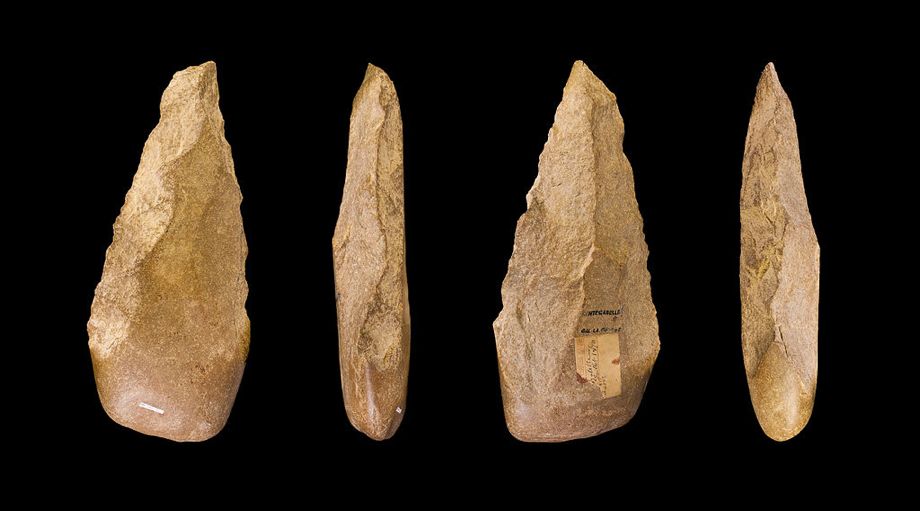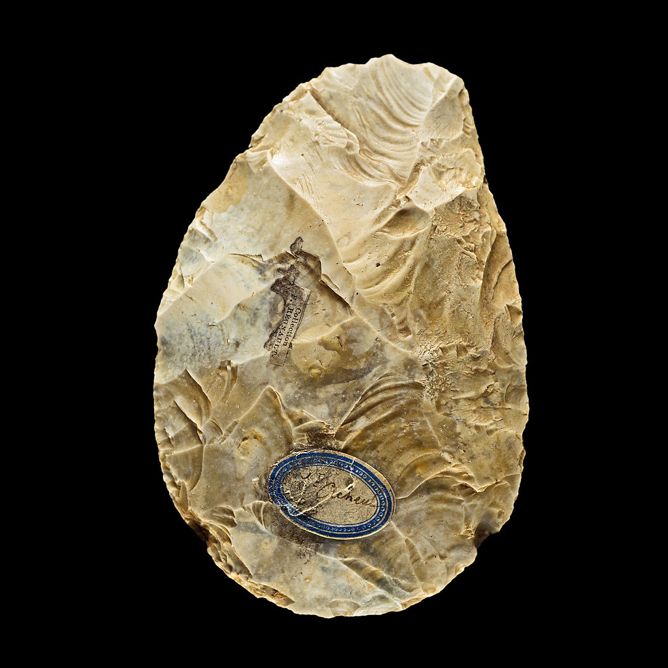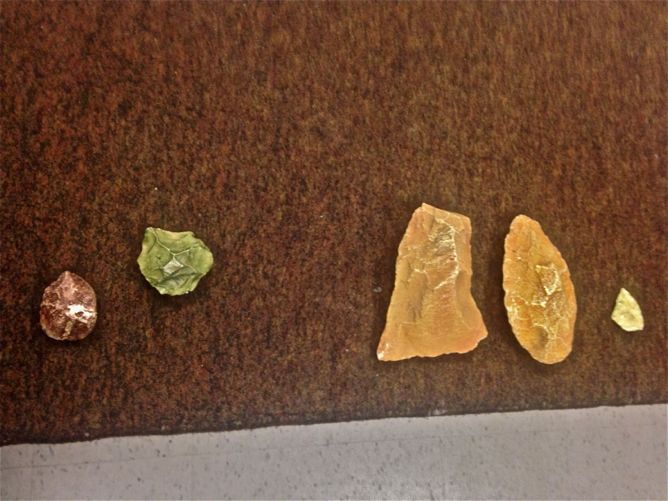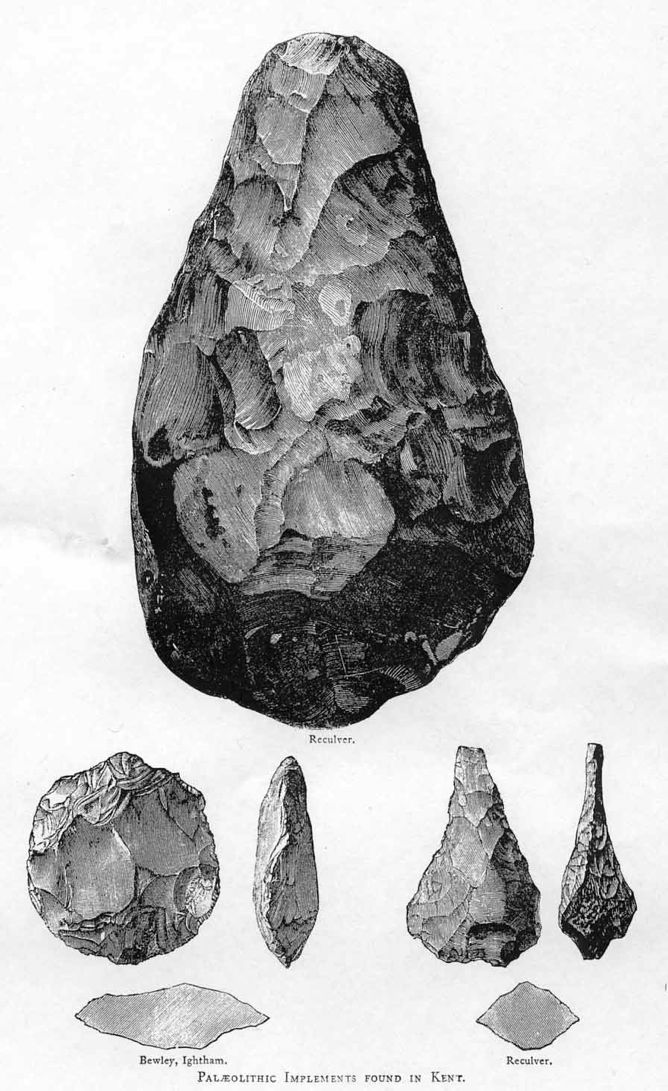What Was the First Item Ever Designed?

Courtesy of Didier Descouens/Wikimedia Commons
Roman Mars’ podcast 99% Invisible covers design questions large and small, from his fascination with rebar to the history of slot machines to the great Los Angeles Red Car conspiracy. Here at The Eye, we cross-post new episodes and host excerpts from the 99% Invisible blog, which offers complementary visuals for each episode.
This week's edition—about the Acheulean hand ax—can be played below. Or keep reading to learn more.
In the beginning, there was design.
Before any other human discipline, even before the dawn of mankind itself, design was a practice passed down from generation to generation of early humans. Today, everything that has been designed—space ships, buildings, pyramids, weapons, clothing, artwork, everything—can be traced back to a single designed object: the Acheulean hand ax.
The Acheulean hand ax does not look like a modern-day ax. There’s no handle and no metal. It could be called the “Acheulean pointy hand rock,” because it is just a rock that has been chipped and shaped, usually into the form of a teardrop.

Courtesy of Didier Descouens/Wikimedia Commons
The term Acheulean refers to where the first specimens were found, on a dig site in Saint-Acheul, France. Other hand axes have been dug up in Africa, Europe, and South Asia.
Early humans created these hand axes by breaking off big pieces with large rocks, and then shaping the fine edge with smaller rocks and pieces of bone. Making one of these things requires effort, skill, and time—anywhere from 15 minutes to several hours.
Acheulean hand axes were the first products of a design process, but they were not the first tools ever made.
The first tools were basically just rocks, or rocks that were chipped with a few major strikes to produce a few sharp edges. Anthropologists call these “Oldowan tools,” which our Homo habilis ancestors would simply go out and select, rather than design.

Courtesy of Avery Trufelman
Selecting Oldowan tools requires cunning, but not craft. When early humans realized that they could fashion more precise tools by sharpening rocks purposefully, the hand ax became the first tool made with an end goal in mind.
An end goal that we today do not know.
Even after finding so many of them, we don’t know how the Acheulean hand ax was used. While it remains a mystery, there are a number of ideas and explanations as to why the hand ax appeared, including:
Theory No. 1: The “Swiss Army Knife” theory. The hand ax could have been a multitool, primarily used for butchering meat, and also good for breaking open nuts or grubs.
Strength of the argument: These uses fit with the wear patterns on the hand axes that have been found.
Weakness of the argument: In some cases, the full perimeter of the ax is sharp. This means that if you wanted to hold it, there’d be a sharp blade digging into your palm. Another problem with this theory is that some of the axes are symmetrical, which requires more effort than necessary if you’re just using it to breaking up nuts or cut meat.
Theory No. 2: The “Sexy Hand Ax” theory. The hand ax didn’t have a “use” per se, and was created mostly as a way of showing off for mate attraction.
Strength of the argument: Making these things is really, really hard. Why spend so much time doing it unless you’re showing off? You’re showing the opposite sex what you can do.
Weakness of the argument: Not all hand axes are nice and neat and symmetrical. There’s a lot of variation, and a lot depends on what rock they’re made of and how precisely the sides have been sharpened. They weren’t all pretty.
Theory No. 3: The “Killer Frisbee” theory. Hand axes were made to be projectiles, thrown in the fashion of the discus in the Olympics.
Strength of the argument: Perhaps hunters would bombard animals with hand axes. This might not be enough to make a kill, but the stones could maim a few and give a hunters an advantage. This hypothesis explains why they’re sharp all the way around, symmetrical, and aerodynamic.
Weakness of the argument: Again, not all hand axes are sharp all the way around and perfectly symmetrical. These things were made on three different continents over the course of a million years. There’s variation.

From the Victoria County History of Kent, Vol. 1, published in London, 1912
No matter what Acheulean technology actually was used for, it must been effective, because this basic design was used for an incomprehensibly long time: Hominid adults were teaching hominid children how to make hand axes for more than a million years.
To learn more, check out the 99% Invisible post or listen to the show.
99% Invisible is distributed by PRX.
